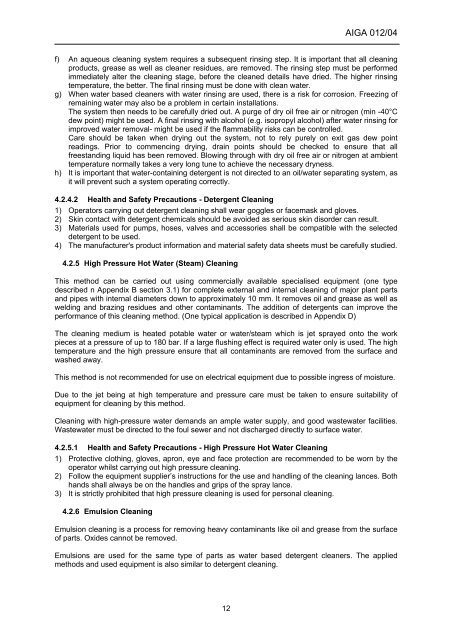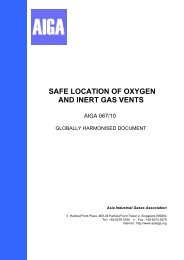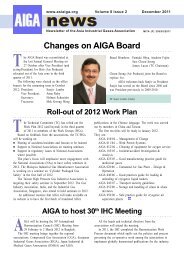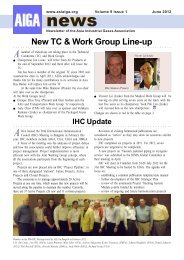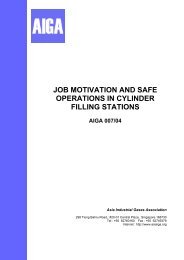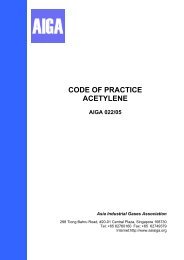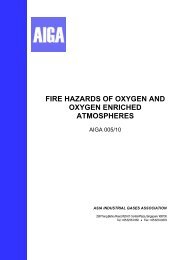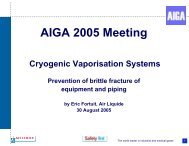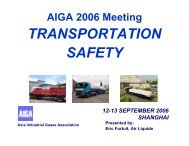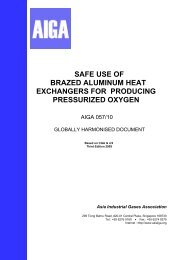CLEANING OF EQUIPMENT FOR OXYGEN SERVICE - AIGA
CLEANING OF EQUIPMENT FOR OXYGEN SERVICE - AIGA
CLEANING OF EQUIPMENT FOR OXYGEN SERVICE - AIGA
Create successful ePaper yourself
Turn your PDF publications into a flip-book with our unique Google optimized e-Paper software.
12<br />
<strong>AIGA</strong> 012/04<br />
f) An aqueous cleaning system requires a subsequent rinsing step. It is important that all cleaning<br />
products, grease as well as cleaner residues, are removed. The rinsing step must be performed<br />
immediately alter the cleaning stage, before the cleaned details have dried. The higher rinsing<br />
temperature, the better. The final rinsing must be done with clean water.<br />
g) When water based cleaners with water rinsing are used, there is a risk for corrosion. Freezing of<br />
remaining water may also be a problem in certain installations.<br />
The system then needs to be carefully dried out. A purge of dry oil free air or nitrogen (min -40°C<br />
dew point) might be used. A final rinsing with alcohol (e.g. isopropyl alcohol) after water rinsing for<br />
improved water removal- might be used if the flammability risks can be controlled.<br />
Care should be taken when drying out the system, not to rely purely on exit gas dew point<br />
readings. Prior to commencing drying, drain points should be checked to ensure that all<br />
freestanding liquid has been removed. Blowing through with dry oil free air or nitrogen at ambient<br />
temperature normally takes a very long tune to achieve the necessary dryness.<br />
h) It is important that water-containing detergent is not directed to an oil/water separating system, as<br />
it will prevent such a system operating correctly.<br />
4.2.4.2 Health and Safety Precautions - Detergent Cleaning<br />
1) Operators carrying out detergent cleaning shall wear goggles or facemask and gloves.<br />
2) Skin contact with detergent chemicals should be avoided as serious skin disorder can result.<br />
3) Materials used for pumps, hoses, valves and accessories shall be compatible with the selected<br />
detergent to be used.<br />
4) The manufacturer's product information and material safety data sheets must be carefully studied.<br />
4.2.5 High Pressure Hot Water (Steam) Cleaning<br />
This method can be carried out using commercially available specialised equipment (one type<br />
described n Appendix B section 3.1) for complete external and internal cleaning of major plant parts<br />
and pipes with internal diameters down to approximately 10 mm. It removes oil and grease as well as<br />
welding and brazing residues and other contaminants. The addition of detergents can improve the<br />
performance of this cleaning method. (One typical application is described in Appendix D)<br />
The cleaning medium is heated potable water or water/steam which is jet sprayed onto the work<br />
pieces at a pressure of up to 180 bar. If a large flushing effect is required water only is used. The high<br />
temperature and the high pressure ensure that all contaminants are removed from the surface and<br />
washed away.<br />
This method is not recommended for use on electrical equipment due to possible ingress of moisture.<br />
Due to the jet being at high temperature and pressure care must be taken to ensure suitability of<br />
equipment for cleaning by this method.<br />
Cleaning with high-pressure water demands an ample water supply, and good wastewater facilities.<br />
Wastewater must be directed to the foul sewer and not discharged directly to surface water.<br />
4.2.5.1 Health and Safety Precautions - High Pressure Hot Water Cleaning<br />
1) Protective clothing, gloves, apron, eye and face protection are recommended to be worn by the<br />
operator whilst carrying out high pressure cleaning.<br />
2) Follow the equipment supplier’s instructions for the use and handling of the cleaning lances. Both<br />
hands shall always be on the handles and grips of the spray lance.<br />
3) It is strictly prohibited that high pressure cleaning is used for personal cleaning.<br />
4.2.6 Emulsion Cleaning<br />
Emulsion cleaning is a process for removing heavy contaminants like oil and grease from the surface<br />
of parts. Oxides cannot be removed.<br />
Emulsions are used for the same type of parts as water based detergent cleaners. The applied<br />
methods and used equipment is also similar to detergent cleaning.


